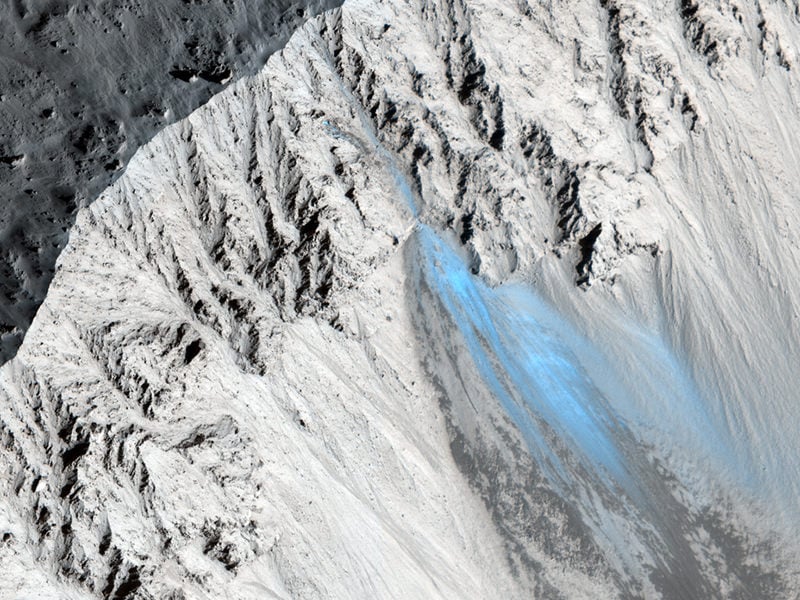[/caption]
Thanks to the Mars Reconnaisance Orbiter and the on-board HiRISE camera, scientists are able to monitor Mars for changes taking place on the landscape. They do this by comparing older images with newer ones, and also by seeing "fresh" features -- like this recent landslide in Zunil Crater. "The color and albedo patterns indicate that a landslide occurred here very recently--too recently to have been re-covered by dust," writes Alfred McEwen, principal investigator of HiRISE, writing on the camera's website. "Looking for changes such as this will help us to better understand active processes." McEwen said the landslide could have been triggered by a Marsquake or a small impact event."
See more recent landslides below:
[caption id="attachment_75788" align="aligncenter" width="580" caption="This landslide was spotted by Stu Atkinson; boulders and debris are below a steep north polar boundary scarp. Credit: NASA/JPL/University of Arizona "]
[/caption]
Our 'eagle-eyed' pal
Stuart Atkinson
found this landslide on a steep scarp in the north polar region. It looks as though a lot of rock has fallen from the cliff, and discussion among other image artists on
UnmannedSpaceflight.com
indicated that the blue areas could easily be patches of ice deposited from the cliff face. You can see the
original image at the HiRISE website.
[caption id="attachment_75789" align="aligncenter" width="580" caption="Frosted Gullies in the Northern Summer. Credit: NASA/JPL/University of Arizona"]
[/caption]
This image is so amazing, in that from orbit, we are looking down the side of a crater wall, where gullies have formed. There are two schools of thought on these types of gullies: one, many scientists believe that these gullies have been carved by liquid water, and were carved recently, so this recent, present-day activity is of immense interest.
A second opinion is that accumulations of frost in the gully alcoves starts an avalanche of loose material that does not involve liquid water. The MRO scientists will continue to analyze many images like this in order to try and answer the broader question of whether liquid water is responsible for the the gullies, landslides and avalanches or not.
[caption id="attachment_75791" align="aligncenter" width="580" caption="andslides along the Walls of Bahram Vallis. Credit: NASA/JPL/University of Arizona"]
[/caption]
This image of Bahram Vallis has large mounds of material at the base of the valley floor. These deposits of material have the characteristic shape of rotational landslides or slumps on Earth where material along the entire wall slumps down and piles debris at the base of the slope, "much like a person who slumps down the back of a chair," writes Frank Chuang from the HiRISE team. "Right at the cliff edge at the top of the slope, the shape of the area where the valley wall gave way to a landslide is not straight, but rather curved or semi-circular. This is typical of large landslides where the failure area has an arcuate "crown" shape. The fact that landslides have occurred here indicates that the valley walls are not stable and the materials respond to Martian gravity with mass movements."
See more images at the HiRISE website.
 Universe Today
Universe Today
